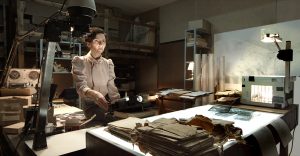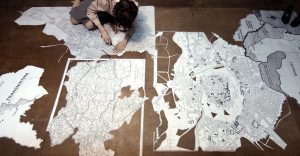NRFF Interviews Artist & Filmmaker Maya Zack
 Counterlight
Counterlight
Movie • 23 min • Experimental, Documentary, Art
Israel
*WINNER of the New Renaissance Best Art Film Award
DIRECTED BY Maya Zack
The film “Counterlight” by Artist Maya Zack is the 3rd part of her Memory Trilogy of award-winning films – following “Mother Economy” and “Black and White Rule”. It’s a hypnotic journey into the depths of consciousness that follows the traces of poet, Paul Celan, one of the greatest poets of the modern-postmodern era.
1.Welcome to the New Renaissance Film Festival. Congratulations on your nominations for ‘Counterlight’. How does it feel to be nominated in 2 categories: Best Documentary and Best Experimental Film?
Thank you very much, I am of course very happy that my film Counterlight is nominated in 2 categories! I must say I’m especially thrilled by the documentary context because for me it very much deals with the notion of documentary itself, with the feasibility of documentation and research and of course with a real person – Paul Celan – his biography and history of his time, although as a film itself is by no means a classic traditional documentary!

2. Tell us about the poet in your film and the journey of the central character. What inspired you to make this documentary film?
The poet the film relates to is Paul Celan (1920-1970), who’s considered to be one of the greatest post-war German-writing poets, one may describe him as ‘Kafka of the poetry’, who was born in Czernowitz (than Romania) to a Jewish family and had barely survived the holocaust. His poetry has a unique, enigmatic and outstanding impact in the way it deals with memory and metaphysics.
The character in my film is an archive researcher that tries tries to decipher Celan’s hermetic poetry, and while doing so, she turns from an archivist to an alchemist : she turns the dead memory of the archive (documents, papers, dry facts and figures, tables and maps) in to a living memory as she penetrates an old street photo in which Celan is coincidentally documented, she intervenes in it and changes the past. Later she imagines Celan’s childhood memory of his mother baking the traditional Shabbat bread (Challah) in her kitchen – a scene that inspires her to set out with her own female magic in the archive. Just like the researched in my film, I was myself inspired by Celan’s amazing and intriguing poems – trying to penetrates his creative process and come close to the secret of creation and transformation! I was also inspired by history, by mystical writings…
3. The set design is stunning. How long did it take you to make this film? What was the most challenging scene to work on and why?
Thank you! The set design is one of my passions. For me it’s like creating a sculptural installation that I can then document in the film. The whole making of the film was very demanding – there were very complicated shooting days, with a lot of crew members, many characters and crazy sets that didn’t make it into the film. on the other hand there were endless shooting days in my studio (the archive location) with only Stanislav Levor (Director of Photography) and myself (performing hands doing the actions), where it was about inventing all those “alternative archive actions” of the researcher, i.e the scene when the researched is dissecting Celan’s poem in an almost surgical manner. there were so many further strange and creative inventions we filmed, also with Michel Weinberg (the actress) that remained on the editing room’s floor. The editing process was especially exhausting due to the amount of materials and so many ideas…. the whole making of the film took 3 years (parallel to other projects) from the very early stages of the concept and research till it was finally made. The filming lasted a few months also while editing.

4. How did you raise the finance for the film?
With self investments and eventually the aid of a few art funds that joined along the way.
5. ‘Counterlight’ is part of a trilogy. How does it relate to the other two films?
‘Counterlight’ relates to the other two film ‘Mother Economy’ and ‘Black and white Rule’ in such a way that they are all dealing with memory, through the somewhat similar periodic setting and female character (somewhere between a clerk-researcher-scientist-artist) while each one of them encounters the mnemonic process in a different phase of its consolidation, with its different relations to reality. In ‘Mother Economy’ the charterer encounters the domestic space and relates to it as a crime scene in the sense that the action already took place, the people are gone but we still have the space, the traces, objects to base our story/memory on. In ‘Black and white Rule’ the character is personifying memory as it is being registered right in proximity to the living reality, while the events happen, while the actions take place. And in ‘Counterlight’, we don’t any living reality anymore, no more people, no objects. The world is now only the archive – populated by researcher alone and only by records, documents, registrations of something that once accrued. We are further away form the events, from the concrete reality. And the feminine character tries to resurrect something out of the records, out of the ashes.
6. Have you always wanted to work in film? What films inspire you?
As an artist I was always looking at filmmaking as something I wanted to come close to and I try to create my own territory in between the two…. I am inspired by the films of Trakovsky, Von Tries, Renais to name a few…
7. What is the central message of ‘Counterlight’ that you want audiences to understand?
That art has a valid role in our existence, in the construction our memory and in launching us into new realms far beyond our physical borders.
8. What are your plans for this film? Have other festivals picked it up?
‘Counterlight’ was primarily part of my solo show at the Tel Aviv Museum of Art (alongside the rest of the trilogy films, installations, drawings and objects), later in was shown in MLF gallery in Rome and Brussels and in various festivals. It will be screened in further festival in the coming months and I would really hope to have the chance to show it further, again in a museum setting..
 Counterlight
Counterlight


